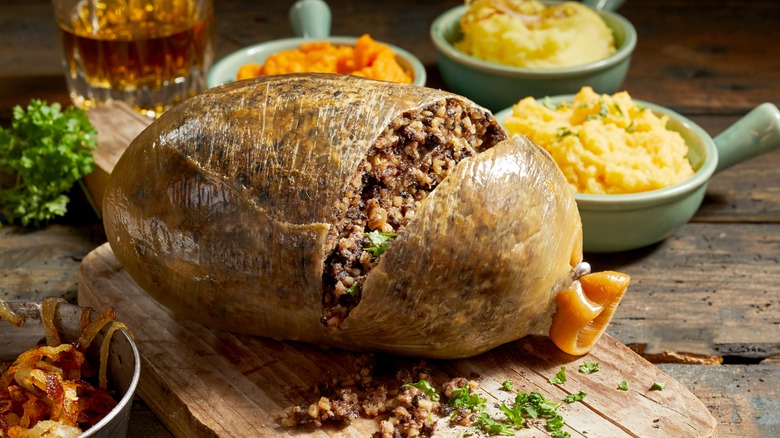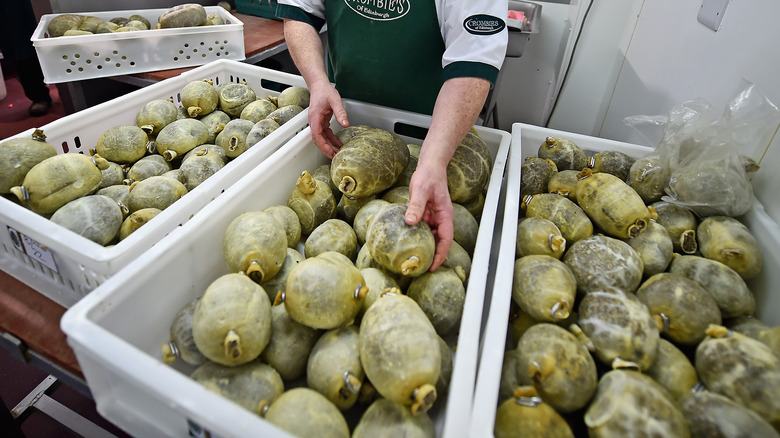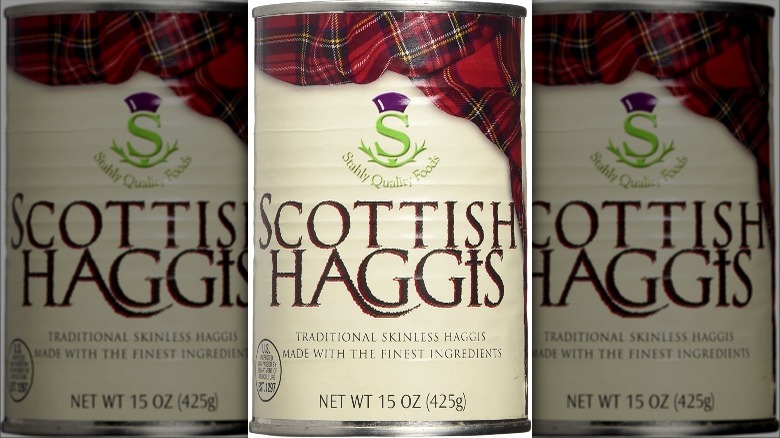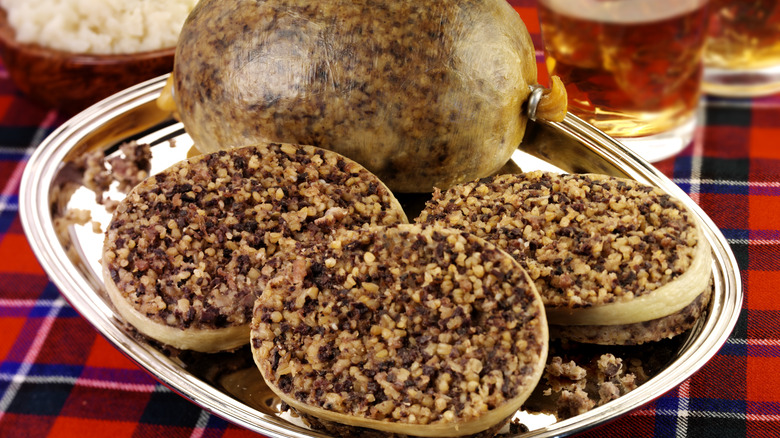The Real Reason Scottish Haggis Is Banned In The US
We may receive a commission on purchases made from links.
CORRECTION 8/4/23: A previous version of this article defined "lamb lobes" as brains; lamb lobes are sheep lungs.
Have you ever eaten haggis? If you're like most Americans, probably not. In fact, you may not even be entirely sure what it is, as a 2003 poll of American tourists visiting Scotland found that 33% of those surveyed thought haggis was some type of animal, reported The Guardian. A strange beast indeed. The offal truth is, haggis is actually a foodstuff concocted of a sheep's stomach and filled with that same (or a different) sheep's liver, heart, and lungs, as well as oatmeal, suet, stock, onions, and spices. Sound yummy?
If that doesn't appeal to you, then chances are you probably haven't been affected too badly by the more than 50-year U.S. ban on authentic Scottish haggis. According to the National Archives' Code of Federal Regulations, Scottish haggis imports have been prohibited by federal law since 1971. But so far, there doesn't appear to be any major efforts to overturn this decision.
Why the USDA won't permit authentic Scottish haggis
As per the U.S. Department of Agriculture's 1971 ruling, "Livestock lungs shall not be saved for use as human food." Instead, non-diseased lungs are allowed to be used in making pet food or employed for pharmaceutical purposes. Interestingly, fluid from the lungs of slaughterhouse cattle can actually help premature babies to breathe. The question remains, though, as to why lungs are prohibited from human consumption while stomach, heart, liver, and all the other stuff in haggis is considered okay. (Not to mention kidneys, which are not used in haggis but are instead baked into a pie that perhaps only a British person could love.)
According to Edward R. Blonz, Ph.D., a nutritional expert who sits on the board of the University of California's Berkeley Wellness, sheep's lungs, in particular, can contain fluid from the stomach, something he refers to as "microbial-rich gunk." There you have it, eating sheep lungs can be a food safety risk.
You can still get USDA-approved haggis
Should you wish to try haggis — the dish is, after all, de rigueur for a proper Burns Night celebration – dinna fash yersel. (Per The Scotsman, this phrase is the Scottish version of "no worries, mate.") There are several different manufacturers who produce lung-free canned haggis for the U.S. market because, yes, there exists a desire. You can purchase these products from, you guessed it, Amazon.
Different brands of canned haggis available include Stahly, which is made with lamb heart and liver, and pork fat, and The Caledonian Kitchen, which is fairly offal-free, as it's made from ground beef and beef suet. The Caledonian Kitchen also offers a frozen haggis made with beef, vegetables, and beef liver. If you're not ready to commit to a whole haggis, though, you can always just buy a bag of haggis-flavored potato chips.
You can also make lung-free haggis
If you're a real do-it-yourselfer, there's also the option to make your own haggis. You can go for a more modern haggis, made with ground beef or lamb in place of the organ meats. Or, if you want to go as authentic as you can get, Alton Brown has a haggis recipe that calls for a sheep's stomach, liver, heart, and tongue. His haggis is entirely lung-free, however, in accordance with U.S. law.
Although haggis fans (or at least non-detractors) describe the dish as tasting like a peppery kind of sausage with a somewhat crumbly texture, even Alton himself seems slightly dubious about eating it. The last step of his recipe notes you can, "Serve with mashed potatoes, if you serve it at all," and the yield is given as, "Depends on how much you throw." Mmm, sounds like a ringing endorsement for the dish.
We don't advise smuggling haggis
While Alton Brown's haggis recipe doesn't instill much confidence, the dish does have its fans. In fact, some people are willing to resort to desperate measures in order to obtain the real deal. Although Canadian laws ban the import or export of sheep lungs, there are still butchers in the Great White North who make haggis in the truly authentic way, lungs and all (per The New York Times). There are also customers in the U.S. who drive across the border to purchase the dish, then attempt to hide it when they cross back into the states.
Other haggis smugglers will go straight to Scotland to buy the stuff, then attempt to disguise it in their luggage. According to the Times, Michelin-starred chef Nick Nairn was able to bring in contraband haggis twice for a Big Apple Burns Night celebration. The third time was not the charm, however, as an airport sniffer dog detected the meaty smell emanating from his suitcase. The haggis was confiscated and destroyed, no doubt to Nairn's and the dog's disappointment, but Nairn didn't really get in any trouble, aside from some temporary embarrassment.
Perhaps the chef might have succeeded had he taken a tip from Canadian haggis maker Paul Bradshaw. As Bradshaw told the Times, "You can kind of get away with it ... I would just label it 'lamb sausage' if I knew they were crossing the border."




